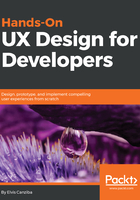
User analysis
To create a great user experience, we have to start by understanding our users. However, only knowing who they are is not enough. We need to dive deeper into their motivations, fears, mentality, and behavior.
User analysis will guide us in finding the answers to our questions about end users' tasks and goals so that these findings can help us make decisions about creating and designing a better product.
By analysis, we will be able to identify roles and define characteristics that aren't always possible through market research, such as knowledge, state of mind, comfort with similar products, use cases and environments, and frequency of use. With this data, it will be much easier for us to do feature changes and improve the user's experience with our product.
By doing a proper user analysis, we will have the following benefits:
- Better product: We will have a better product because we also involved the user by understanding the business objectives, which will always result in a product that will work better for their specific purpose.
- Cheaper to fix the problem: It will help us to face the reality of our product and change things that won't work while we still have the product only on paper. Making changes to wireframes or prototypes is much cheaper than trying to fix something technical on a live product.
- Easy to use is a common requirement: Customers often use the terms usability and user experience when describing qualities they seek in products. Therefore, user analysis drives our product to have better selling points.
User analysis will allow us to create a better product that will work for them; if we ignore user analysis, then the product wasn't created for the users–it means that we lost time and resources creating the product that we wanted and not the one the users did. Users don't care if our product has tons of features, or if it can do a thousand things; they just need a product that works for them.
To clarify this process, and to not get you more confused, I'll try to keep it clear: UX analysis is the phase where you start to analyze all the data and insights that you got from the previous stages, especially from the research phase, and convert them into a clear document or specification to have an understandable meaning for the whole team.
I hope that it is now clear and that you understand the difference between all the stages that we've explained so far about UX research methods and the UX process itself, and how to analyze data so that you can start implementing it right away in your design process. Use it as early as possible and as often as possible in your process of product design to provide the benefits of a better user experience to your users.